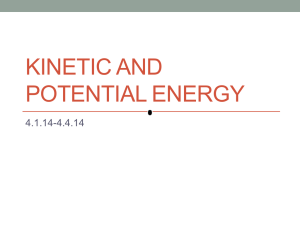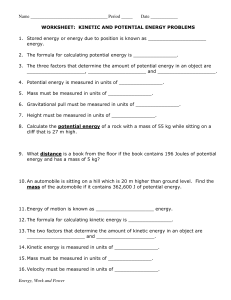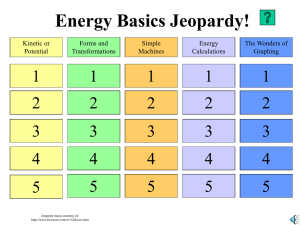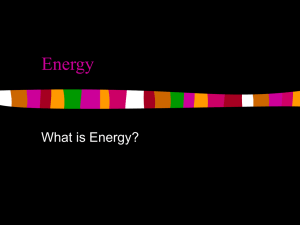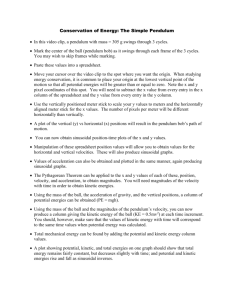Energy and Oscillations
advertisement
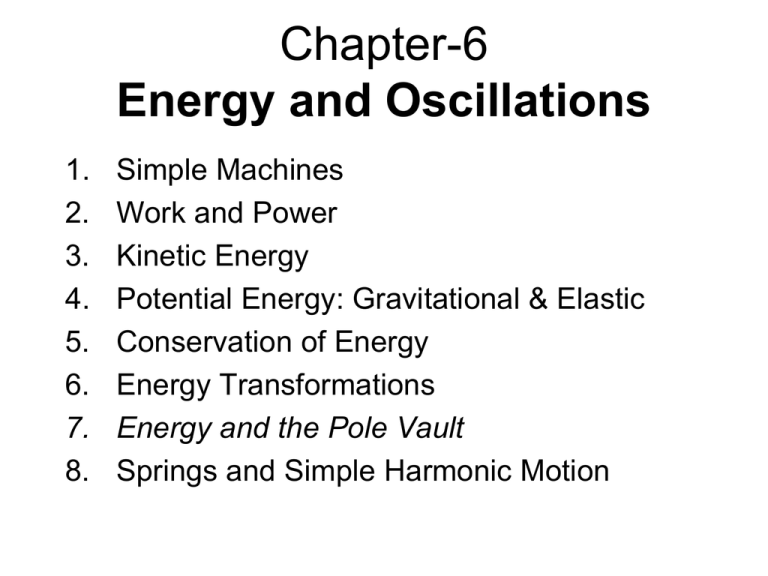
Chapter-6 Energy and Oscillations 1. 2. 3. 4. 5. 6. 7. 8. Simple Machines Work and Power Kinetic Energy Potential Energy: Gravitational & Elastic Conservation of Energy Energy Transformations Energy and the Pole Vault Springs and Simple Harmonic Motion Simple Machines A simple machine is any mechanical device that multiplies the effect of an applied force. Pulley System Lever Work Work done in moving an object by a force is defined as follows: Work = Force Distance. W = F d. Here the force acts along the distance. Work is a scalar. The SI unit for work is, N.m = joule = J Q: Ramps enable loading easy. Explain why? (Try SP6, p123) Does any force do work? E5: a. Work done by the 30 N force? b. Work done by the 40 N force? c. Work done by the 50 N force? Q: Work done in pushing an immobile wall? W=Fd Power The rate at which work is done is called the power. Work Power . Time Power is a scalar quantity. The SI unit for power is Watt, W. 1 W = 1 J/s. Before the arrival of machines horses were used to do work. With this originated the unit horsepower, hp. 1 hp = 746 W = 550 ft•lb/s. Why mountain roads are made round and round not straight up? Kinetic Energy Kinetic energy is the energy of motion. The word “kinetic” originated from the Greek word kinetikos, meaning “motion”. If an object of mass, m moves with a velocity v, then the kinetic energy, KE is given by the following equation, 1 2 KE mv . 2 Kinetic energy is a scalar quantity. It also has the same unit as work, joule (J). 1 J = 1 kg.m2/s2. W = F d = KEf KEi. Positive work Negative work Gravitational Potential Energy Gravitational potential energy, GPE is the energy stored in an object as a result of its height. It can be calculated using weight, which is mass times gravity, and height. It is given by the following equation, GPE m gh. Gravitational potential energy is a scalar quantity. The SI unit for it is also joule, J. Elastic Potential energy Elastic potential energy is the energy stored in elastic materials as the result of their stretching or compressing. 1 2 EPE kx 2 How shock absorbers work? Conservation of Energy The swing of the pendulum demonstrates the principle of conservation of energy. Mechanical energy = KE + PE In the absence of friction and air drag, the total mechanical energy of a system remains a constant. http://www.youtube.com/watch?v=BVxEEn3w688 How is energy analysis like accounting? Try SP5, p122. Forms of Energy and Transformations Energy Transformations Process/Device Initial form of energy Photosynthesis Light bulb Electric motor Electric generator Solar still Photovoltaic cell (solar cell) During friction Using a battery Charging a battery In a microphone In a loudspeaker In a nuclear reactor Final form of energy Energy Transformations in Pole Vault Forms of Energy: Energy Transformations: Springs and Simple Harmonic Motion Amplitude is the maximum distance from equilibrium. Period, T is the time taken for one complete cycle. Frequency,f: Number of cycles per unit time. 1 f . T 1. A force of 70 N is applied to a crate parallel to the surface on which the crate rests. If the force moves the crate 6.0 m calculate the work done by the force. 2. If the force in problem 1 was applied for 8.0 seconds how much power was expended? 3. An object of mass 3.0 kg has a velocity of 8.0 m / s. What is the object's kinetic energy? 4. A monkey carries a coconut of mass 2.0 kg to a height of 10 m. Calculate the potential energy of the coconut and the work done by the monkey in getting the coconut to that height. 5. A pendulum of mass 2.0 kg is raised to a height of 0.4 m above the lowest point in its swing and then is released from rest. If air resistance can be ignored, how high will the pendulum swing on the other side of its motion? 6. For the pendulum in the previous problem, how fast will it move at the lowest point in its swing? 7. SP5 p122 and SP6, p123.



